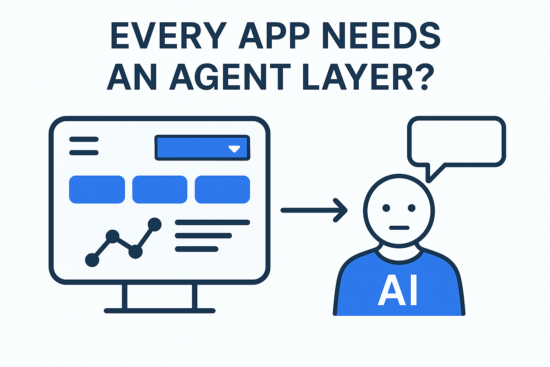I’ve been building apps for years—web apps, internal tools, customer portals. I’ve spent countless hours wireframing UI flows, debating button placements, and testing dropdown logic.
But over the past year—after building, integrating, and observing agent-based AI systems—one question has kept resurfacing:
Why are we still building apps like it’s 2012?
Why are users forced to learn the UI, instead of the app learning the user?
And the boldest version of that thought:
Should every app now have an agent layer?
My take:
Yes—for most apps
No—for some
But it will soon be expected by users, just like search bars and chatbots were once novelties.
Let’s unpack this.

What Do I Mean by “Agent Layer”?
An agent layer is not just a chatbot.
It’s an intelligent layer that:
-
Interacts with users via natural language
-
Understands goals, not just inputs
-
Executes actions on the user’s behalf
-
Can plan, reason, retrieve, and act inside the app’s boundaries
-
Feels like a helpful teammate, not just an interface
Think:
-
“Book me a meeting with Sarah and attach the Q2 deck” → done.
-
“Generate a campaign draft and A/B test the copy” → done.
-
“Pull all the customer feedback tagged ‘cancelled’ last week and summarize it” → done.
No menus. No hunting. No clicking 14 times to do what a sentence can express.
Why This Shift Feels Inevitable
I’ve been observing user behavior for years. And here’s the honest truth:
Most people don’t want to learn your UI.
They just want to get stuff done.
Every new feature you add? More cognitive load.
Every dropdown with 50 items? A mini UX tax.
But when you give people an agent interface—something they can talk to like a smart colleague—you reduce that friction dramatically.
We’ve already trained a generation of users to type into search bars. Now we’re training them to talk to systems like humans.
That’s not a UX gimmick. That’s a paradigm shift.
Real Examples from My Experience
Let’s get practical.
Invoicing App → Agent Layer
Instead of:
-
Click “New Invoice”
-
Select customer
-
Add line items manually
Now:
“Create an invoice for Acme Corp for last month’s services and email it.”
Customer Support CRM → Agent Layer
Instead of:
-
Filter by last ticket status
-
Check 4 columns
-
Manually tag for escalation
Now:
“Show me unresolved tickets older than 48 hours with negative sentiment, and flag the top 5.”
Marketing Analytics Dashboard → Agent Layer
Instead of:
-
Select time range
-
Apply 3 filters
-
Export report
Now:
“Give me a summary of paid campaign performance last quarter compared to organic traffic.”
The Benefits Are Bigger Than You Think
1. Accessibility
Agent layers don’t care if you’re a power user or a newbie. Everyone speaks the same language—literally.
2. Speed
Common tasks become one-liners. Power users stop needing shortcuts—they just describe what they want.
3. Focus
Agents reduce UI overload. Your app becomes goal-first, not feature-first.
4. Hidden Feature Discovery
Most users never find 90% of your app’s features. Agents surface them contextually. Imagine being asked, “Want me to optimize that schedule for cost?”
But It’s Not for Every App (Yet)
Yes, there are caveats.
-
Mission-critical software: Users may not want an AI to interpret nuclear launch codes or payroll.
-
Precision control apps (e.g., CAD tools, photo editors): Agent layers can supplement, but not replace.
-
Real-time apps: Speed of clicks still beats parsing a sentence.
And more importantly: bad agents ruin trust.
If your agent fails 30% of the time, users will never try it again.
This isn’t autocomplete—it’s delegation.
How to Actually Add an Agent Layer
This is the part where most teams get stuck.
Here’s what worked for me:
1. Start narrow
Pick 3-5 high-value tasks your users repeat. Wrap them in agent logic.
2. Use existing infra
Tools like LangChain, LangGraph, AutoGen, and CrewAI let you plug LLMs into apps without reinventing everything.
3. Design with fallback paths
Let users bail out to the UI anytime. Agents are assistants, not jailers.
4. Add memory
Short-term context (last actions) and long-term memory (user preferences) make agents 10x smarter.
5. Wrap it in trust
Log actions, show previews, confirm big steps. Autonomy needs transparency.
The Deeper Shift: From Apps to Behaviors
Here’s my final (and maybe boldest) opinion:
In 5 years, most users won’t ask,
“How do I do this in the app?”
They’ll ask,
“Can my agent handle this for me?”
We’re moving from:
-
Apps → Agents
-
Clicks → Commands
-
UX → Intent resolution
That shift is already underway. Look at Notion AI, Linear’s issue assistant, or Intercom’s Fin. And soon? It’ll be everywhere.
